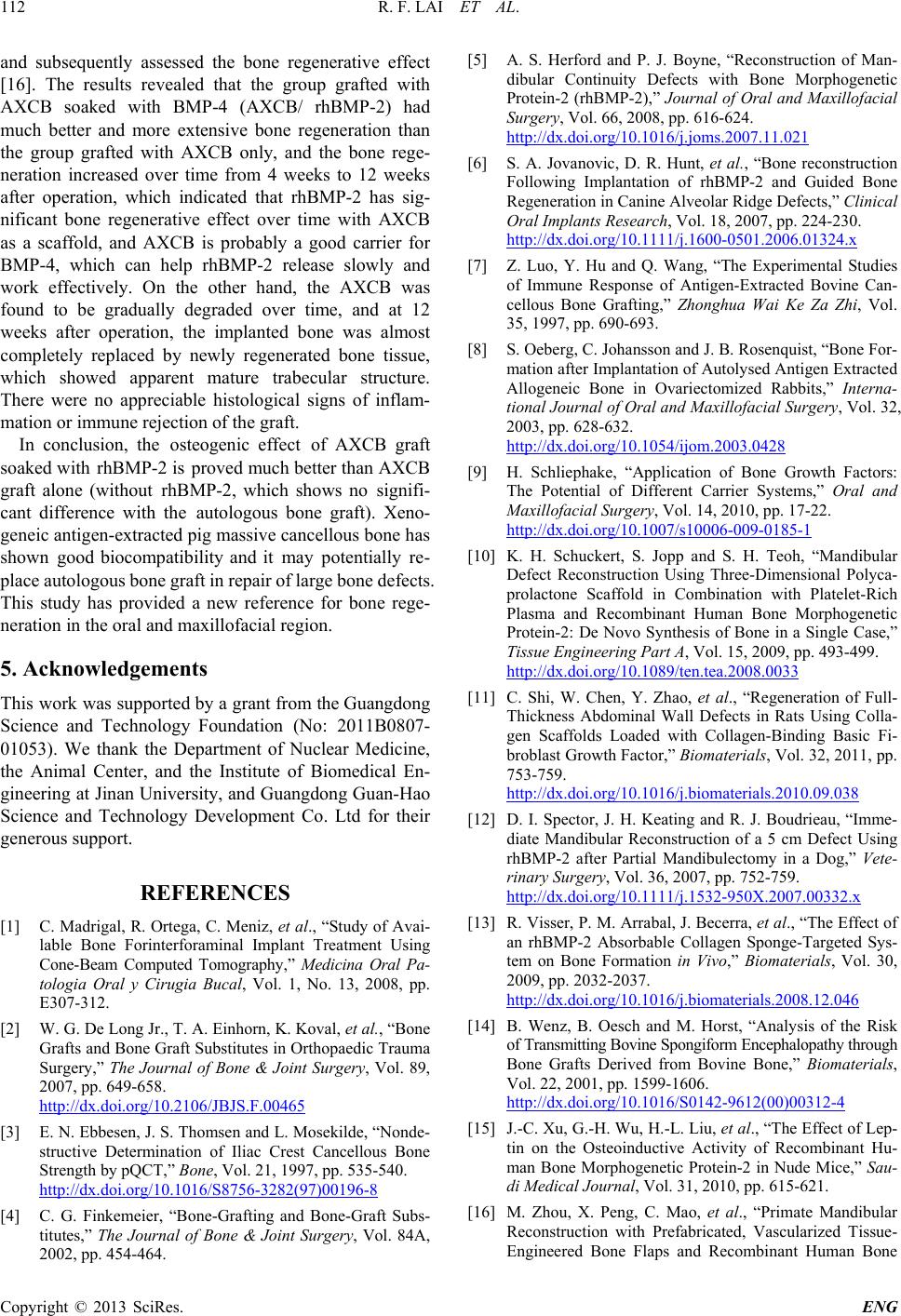
R. F. LAI ET AL.
Copyright © 2013 SciRes. ENG
and subsequently assessed the bone regenerative effect
[16]. The results revealed that the group grafted with
AXCB soaked with BMP-4 (AXCB/ rhBMP-2) had
much better and more extensive bone regeneration than
the group grafted with AXCB only, and the bone rege-
neration increased over time from 4 weeks to 12 weeks
after operation, which indicated that rhBMP-2 has sig-
nificant bone regenerative effect over time with AXCB
as a scaffold, and AXCB is probably a good carrier for
BMP-4, which can help rhBMP-2 release slowly and
work effectively. On the other hand, the AXCB was
found to be gradually degraded over time, and at 12
weeks after operation, the implanted bone was almost
completely replaced by newly regenerated bone tissue,
which showed apparent mature trabecular structure.
There were no appreciable histological signs of inflam-
mation or immune rejection of the graft.
In conclusion, the osteogenic effect of AXCB graft
soaked with rhBMP-2 is proved much better than AXCB
graft alone (without rhBMP-2, which shows no signifi-
cant difference with the autologous bone graft). Xeno-
geneic antigen-extracted pig massive cancellous bone has
shown good biocompatibility and it may potentially re-
place aut ologo us bone graf t in re pair of l arg e bone de fect s.
This study has provided a new reference for bone rege-
neration in the oral and maxillofacial region.
5. Acknowledgements
This work was supported by a grant from the Guangdong
Science and Technology Foundation (No: 2011B0807-
01053). We thank the Department of Nuclear Medicine,
the Animal Center, and the Institute of Biomedical En-
gineering at Jinan University, and Guangdong Guan-Hao
Science and Technology Development Co. Ltd for their
generous support.
REFERENCES
[1] C. Madrigal, R. Ortega, C. Meniz, et al., “Study of Avai-
lable Bone Forinterforaminal Implant Treatment Using
Cone-Beam Computed Tomography,” Medicina Oral Pa-
tologia Oral y Cirugia Bucal, Vol. 1, No. 13, 2008, pp.
E307-312.
[2] W. G. De Long Jr., T. A. Einhorn, K. Koval, et al., “Bone
Grafts and Bone Graft Substitutes in Orthopaedic Trauma
Surgery,” The Journal of Bone & Joint Surgery, Vol. 89,
2007, pp. 649-658.
http://dx.doi.org/10.2106/JBJS.F.00465
[3] E. N. Ebbesen, J. S. Thomsen and L. Mosekilde, “Nonde-
structive Determination of Iliac Crest Cancellous Bone
Strength by pQCT,” Bone, Vol. 21, 1997, pp. 535-540.
http://dx.doi.org/10.1016/S8756-3282(97)00196-8
[4] C. G. Finkemeier, “Bone-Grafting and Bone-Graft Subs-
titutes,” The Journal of Bone & Joint Surgery, Vol. 84A,
2002, pp. 454-464.
[5] A. S. Herford and P. J. Boyne, “Reconstruction of Man-
dibular Continuity Defects with Bone Morphogenetic
Protein-2 (rhBMP-2),” Journal of Oral and Maxillofacial
Surgery, Vol. 66, 2008, pp. 616-624.
http://dx.doi.org/10.1016/j.joms.2007.11.021
[6] S. A. Jovanovic, D. R. Hunt, et al., “Bone reconstruction
Following Implantation of rhBMP-2 and Guided Bone
Regeneration in Canine Alveolar Ridge Defects,” Clinical
Oral Implants Research, Vol. 18, 2007, pp. 224-230.
http://dx.doi.org/10.1111/j.1600-0501.2006.01324.x
[7] Z. Luo, Y. Hu and Q. Wang, “The Experimental Studies
of Immune Response of Antigen-Extracted Bovine Can-
cellous Bone Grafting,” Zhonghua Wai Ke Za Zhi, Vol.
35, 1997, pp. 690-693.
[8] S. Oeberg, C. Johansson and J. B. Rosenquist, “Bone For-
mation after Implantation of Autoly s ed Ant ige n E xtracted
Allogeneic Bone in Ovariectomized Rabbits,” Interna-
tional Journal of Oral and Maxillofacial Surgery, Vol. 32,
2003, pp. 628-632.
http://dx.doi.org/10.1054/ijom.2003.0428
[9] H. Schliephake, “Application of Bone Growth Factors:
The Potential of Different Carrier Systems,” Oral and
Maxillofacial Surgery, Vol. 14, 2010, pp. 17-22.
http://dx.doi.org/10.1007/s10006-009-0185-1
[10] K. H. Schuckert, S. Jopp and S. H. Teoh, “Mandibular
Defect Reconstruction Using Three-Dimensional Polyca-
prolactone Scaffold in Combination with Platelet-Rich
Plasma and Recombinant Human Bone Morphogenetic
Protein-2: De Novo Synthesis of Bone in a Single Case,”
Tissue Engineering Part A, Vol. 15, 2009, pp. 493-499.
http://dx.doi.org/10.1089/ten.tea.2008.0033
[11] C. Shi, W. Chen, Y. Zhao, et al., “Regeneration of Full-
Thickness Abdominal Wall Defects in Rats Using Colla-
gen Scaffolds Loaded with Collagen-Binding Basic Fi-
broblast Growth Factor,” Bi omaterials, Vol. 32, 2011, pp.
753-759.
http://dx.doi.org/10.1016/j.biomaterials.2010.09.038
[12] D. I. Spector, J. H. Keating and R. J. Boudrieau, “Imme-
diate Mandibular Reconstruction of a 5 cm Defect Using
rhBMP-2 after Partial Mandibulectomy in a Dog,” Vete-
rinary Surgery , Vol. 36, 2007, pp. 752-759.
http://dx.doi.org/10.1111/j.1532-950X.2007.00332.x
[13] R. Visser, P. M. Arrabal, J. Becerra, et al., “The Effect of
an rhBMP-2 Absorbable Collagen Sponge-Targeted Sys-
tem on Bone Formation in Vivo,” Biomaterials, Vol. 30,
2009, pp. 2032-2037.
http://dx.doi.org/10.1016/j.biomaterials.2008.12.046
[14] B. Wenz, B. Oesch and M. Horst, “Analysis of the Risk
of Transmitting Bovine Spongiform Encephalopathy through
Bone Grafts Derived from Bovine Bone,” Biomaterials,
Vol. 22, 2001, pp. 1599-1606.
http://dx.doi.org/10.1016/S0142-9612(00)00312-4
[15] J.-C. Xu, G.-H. Wu, H.-L. Liu, et al., “The Effect of Lep-
tin on the Osteoinductive Activity of Recombinant Hu-
man Bone Morphogenetic Protein-2 in Nude Mice,” Sau-
di Medical Journal, Vol. 31, 2010, pp. 615-621.
[16] M. Zhou, X. Peng, C. Mao, et al., “Primate Mandibular
Reconstruction with Prefabricated, Vascularized Tissue-
Engineered Bone Flaps and Recombinant Human Bone